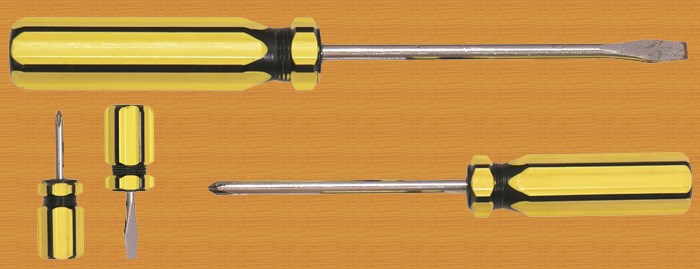Toolbox tips: Seven essentials for every home
DIY can be a really satisfying way to maintain and improve your home, but first you need the right tools in your box. We’ve asked expert odd job man David Ades, who has been trading as DIY Dave Handyman across the north west for 25 years, to show us the seven tools that he couldn’t live without.
1. Tape measure

Always remember that old builder’s proverb: measure twice, cut once. Whatever job you’re doing, it pays to be accurate. A spring-loaded five meter metal tape measure with a locking mechanism shouldn’t set you back much more than £5, and can help you avoid making any expensive mistakes. Use it to plan out all your work before you start.
David says:
“Planning your DIY carefully really is important. For jobs like putting up a curtain pole or hanging a picture, it can also be useful to have a spirit level handy, as well as a tape measure to make sure everything is straight. The longer the spirit level, the more accurate it is.”
2. Flat head and Phillips screwdrivers

There aren’t many DIY jobs that don’t require a screwdriver, from changing a plug to putting up shelves. Using the wrong type or size of screwdriver can damage the screw, so make sure you have a variety of sizes of the two most common kinds: flat head and Phillips, which is cross shaped at the end.
David says:
“If you are using screws to attach something heavy to a wall, like shelves, you may need to use plastic wall plugs which help secure the screws into the wall tightly. They help support the weight of the shelf and keep it secure.”
3. Electric drill

An electric drill could save you hours of effort, especially on jobs like putting up shelves or building flat pack furniture. What type you will need depends what you plan to use it for, so it’s best to talk it through with the store assistant. For basic DIY, a cordless power drill with a rechargeable battery will be fine for drilling into softer surfaces like wood and plaster, but you may need a more powerful model for tough materials like concrete.
David says:
“As always, safety first: be sure not to drill near hidden cables or pipes. Electric cables usually run inside the wall vertically above or below light switches and sockets. If you drill into walls remember to protect the carpet as the red brick dust can cause stains.”
4. Claw hammer

Choose a sturdy claw hammer, which has a curved, v-shaped slot on one side, which can be used to grip and pull out any nails that need removing - useful for removing old or damaged nails.
David says:
"For some simple jobs, like putting up pictures and mirrors, there are kits available from DIY stores which include an assortment of hangers and pins that you can hammer into the wall. Heavy mirrors will, of course, require stronger wall fixings and screws, rather than just nails.”
5. Pliers

Pliers, again, come in a huge variety of shapes and sizes. A pair that can be used for a combination of tasks will be the most useful, like the ones above. The jaws have a sharp scissor-like section for cutting electrical wires, a section for gripping round objects like a stubborn bolt or screw, and a flat section for flat or square objects.
David says:
“Electrical repairs should be limited to changing a plug, fuse or light bulb. If you do attempt to replace a complete light fitting or wall switch, always turn the electricity off at the distribution board, or better still call an electrician.”
6. Utility knife

A sturdy knife with a retractable blade can be used for everything, from trimming vinyl flooring to size, to scratching old grout or sealant from between bathroom tiles. Use strong gloves for safety.
David says:
“Unwanted holes in plaster walls or ceilings can be filled with ready mixed filler and a flat blade, then sanded smooth with a sanding block ready for painting.”
7. Adjustable spanner

The jaws of an adjustable spanner can be opened and closed to fit nuts and bolts of different sizes, so it’s like having a draw full of different sized spanners in one tool. It’s versatile, space-saving, and means you don’t have to shell out for a full spanner set to tackle a range of jobs.
David says:
“A simple way of easing stiff nuts and bolts is to use an oil spray. It can also be used on locks and squeaky hinges. Always have some kitchen paper handy to wipe away any drips.”
Find out more about Home Insurance from Swinton...
- Combined Home Insurance - Protect your home and its contents
- Buildings Insurance - Flexible buildings cover to suit your needs
- Contents Insurance - Protect your possessions from loss or damage
See our Home Products >